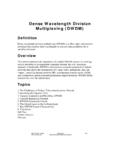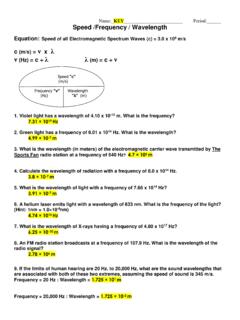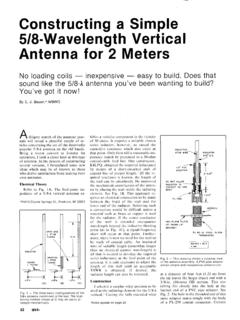Transcription of Core practical 8: Determine the wavelength of light from a ...
1 EDEXCEL Physics Teacher Resource Pack 1 Pearson Education Ltd 2015 This document may have been altered from the original 1 Core practical 8 Teacher sheet Determine the wavelength of light from a laser or other light source using a diffraction grating practical activities have been safety checked but not trialled by CLEAPSS. Users may need to adapt the risk assessment information to local circumstances. Core practical 8: Determine the wavelength of light from a laser or other light source using a diffraction grating Objective To make measurements of laser light passing through a diffraction grating to Determine the wavelength of the light Safety Specification links Lasers should be Class 2 and have a maximum output of 1 mW. They present little risk in the laboratory, providing sensible precautions are taken to reduce the risk of the accidental passage of light into eyes. CLEAPSS Laboratory Handbook, section and publication PS52 are helpful.
2 Follow the usual electrical precautions for mains apparatus, including a visual inspection of the supply lead. practical techniques 1, 3, 10 CPAC 1a, 2a, 4a Procedure Notes on procedure 1. Place the laser approximately 4 m away from a large wall and place the diffraction grating in front of it. Arrange for the beam to pass through the grating at normal incidence and meet the wall perpendicularly. 2. Measure the distance D between the grating and the wall. 3. Turn on the laser and identify the zero order maximum (straight through). Measure the distance s to the nearest two first order maxima. Calculate the mean of these two values. The first order is the maximum produced according to n = 1 in the equation n = d sin 4. Measure s for increasing orders. 5. Repeat for a diffraction grating with a different number of slits/mm. Care should be taken that reflected laser light is unlikely to enter any eyes although lasers are now thought less harmful than was once the case.
3 Normal reflexes, such as blinking and turning away, are most helpful if laser light of this strength does enter the eye. Students should be reminded that some laser sources can be dangerous. Answers to questions 1. Laser light is monochromatic so the maximum is small. It is also coherent, so the maximum is produced without further focussing. The light is bright and a large value for D can be used without the maxima becoming too dim to see properly. 2. A resolution of 1 mm is suitable when measuring distances of around 70 cm for the 300 slits/mm grating and around 25 cm for the 100 slits/mm grating. This gives percentage uncertainties of and respectively. 3. Since white light is a mixture of frequencies, the diffraction would be different for each frequency. The maxima are small so, in practice, the inner edge would be blue-ish and the outer edge red-ish. EDEXCEL Physics Teacher Resource Pack 1 Pearson Education Ltd 2015 This document may have been altered from the original 2 Core practical 8 Teacher sheet Determine the wavelength of light from a laser or other light source using a diffraction grating practical activities have been safety checked but not trialled by CLEAPSS.
4 Users may need to adapt the risk assessment information to local circumstances. Sample data The distance between adjacent maxima has been recorded as this is what was measured. Two gratings were used. The results give = 625 nm and 624 nm respectively, for the 300 slits/mm grating. For the 100 slits/mm grating, = 636 nm and 640 nm. The accepted value is 635 nm. The mean of these four values is 631 nm which gives a percentage difference of 300 slits/mm s1/cm s2/cm s/cm Total s/cm n = 0 to 1 n = 1 to 2 100 slits/mm s1/cm s2/cm s/cm Total s/cm n = 0 to 1 n = 1 to 2 EDEXCEL Physics Teacher Resource Pack 1 Pearson Education Ltd 2015 This document may have been altered from the original 1 Core practical 8 Student sheet Determine the wavelength of light from a laser or other light source using a diffraction grating practical activities have been safety checked but not trialled by CLEAPSS. Users may need to adapt the risk assessment information to local circumstances.
5 Core practical 8: Determine the wavelength of light from a laser or other light source using a diffraction grating Objective To make measurements of laser light passing through a diffraction grating to Determine the wavelength of the light Safety Lasers should be Class 2 and have a maximum output of 1 mW. They present little risk in the laboratory, providing sensible precautions are taken to reduce the risk of the accidental passage of light into eyes. CLEAPSS Laboratory Handbook, section and publication PS52 are helpful. Follow the usual electrical precautions for mains apparatus, including a visual inspection of the supply lead. All the maths you need n = d sin , where sin can be derived from tan = sD and s is the distance between maxima. d is the distance between adjacent slits so d = 1N, where N is the number of slits per metre. Recognise and make use of appropriate units in calculations. Recognise and use expressions in decimal and standard form.
6 Use calculators to handle sin x, cos x, tan x when x is expressed in degrees or radians. Use an appropriate number of significant figures. Find arithmetic means. Change the subject of an equation, including non-linear equations. Substitute numerical values into algebraic equations using appropriate units for physical quantities. Use angles in regular 2D and 3D structures. Use sin, cos and tan in physical problems. Equipment source of laser light diffraction grating, supported at the same height as the laser beam metre ruler Procedure 1. Place the laser approximately 4 m away from a large wall and place the diffraction grating in front of it. Arrange for the beam to pass through the grating at normal incidence and meet the wall perpendicularly. 2. Measure the distance D between the grating and the wall. 3. Turn on the laser and identify the zero order maximum (straight through). Measure the distance s to the nearest two first order maxima.
7 Calculate the mean of these two values. The first order is the maximum produced according to n = 1 in the equation n = d sin 4. Measure s for increasing orders. 5. Repeat for a diffraction grating with a different number of slits/mm. EDEXCEL Physics Teacher Resource Pack 1 Pearson Education Ltd 2015 This document may have been altered from the original 2 Core practical 8 Student sheet Determine the wavelength of light from a laser or other light source using a diffraction grating practical activities have been safety checked but not trialled by CLEAPSS. Users may need to adapt the risk assessment information to local circumstances. Analysis of results 1. Since the angle is not small, you will have to calculate from your measurements for s and D. Calculate a mean value for each order. 2. Calculate a mean value for the wavelength of the laser light and compare your value with the accepted wavelength (of 635 nm for the standard school red laser).
8 Questions 1. State the advantages of using laser light in this experiment. 2. Explain why a metre ruler is suitable for measuring the distance in the experiment. 3. Suppose that a white light laser were possible. Describe what the diffraction maxima would look like. EDEXCEL Physics Teacher Resource Pack 1 Pearson Education Ltd 2015 This document may have been altered from the original 1 Core practical 8 Technician sheet Determine the wavelength of light from a laser or other light source using a diffraction grating practical activities have been safety checked but not trialled by CLEAPSS. Users may need to adapt the risk assessment information to local circumstances. Core practical 8: Determine the wavelength of light from a laser or other light source using a diffraction grating Objective Safety To make measurements of laser light passing through a diffraction grating to Determine the wavelength of the light Lasers should be Class 2 and have a maximum output of 1 mW.
9 They present little risk in the laboratory, providing sensible precautions are taken to reduce the risk of the accidental passage of light into eyes. CLEAPSS Laboratory Handbook, section and publication PS52 are helpful. Follow the usual electrical precautions for mains apparatus, including a visual inspection of the supply lead. Equipment per student/group Notes on equipment source of laser light See CLEAPPSS Handbook and publication PS52 for safety advice. A Labjack is useful to support the device at a suitable height. If there is any doubt about the class of the laser, do not use it. diffraction grating, supported at the same height as the laser beam Support can be a retort stand providing laser can be raised safely. 300 slits/mm is suitable, as are 100 slits/mm and 600 slits/mm. metre ruler Sonic tape measure would be suitable for measuring D, but not s, the distance between maxima. Notes















